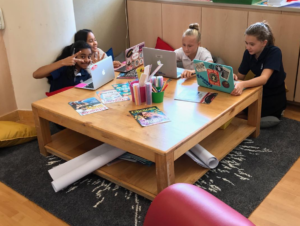The Family Values & Mission Statement Project
Values are formed through a variety of sources – family, culture, religion, media, peers – but in early adolescence, the majority of values are still shaped by parents. Openly communicating what those values are can help students avoid risky behaviors and make healthy decisions as they begin to navigate the tricky waters of peer pressure.
Use this project to encourage kids to sit down with their parents and discuss their family values.
Pre-learning activity:
Send students home with a word bank of values from Values.com and have them work with their family to pick their top five values. They will discuss the definitions of these values, their origins, and times when they have demonstrated them as a family.
(Assign this task about a week before starting the in class portion of the project so the kids have plenty of time to schedule a meeting with their parents.)
Project Sheet- Family Values and Mission
Family Values and Mission Statement
Day 1 & 2
What steers our decision-making process?
- Watch The Happy Movie
This excellent documentary reveals the science behind what makes life meaningful. It’s an enjoyable, informative watch, and its strong focus on values will be helpful to students as they engage in their discussions at home.
- Remind students to complete their family interview before next class so they can use the time to work on their projects.
Day 3-
Family Values
- Journal: How did your family meeting go? Did you all agree on the same values, or did you have a hard time seeing eye-to-eye?
- Give students the rest of class to work on the definitions, origins, and examples of their family values on their computers. I try to conference with each student during this part, as they usually need some help.
Day 4 & 5-
Mission Statements
- Hand out the NBA mission statement: Have students read the document and find words representative of values and character strengths. They will then write their observations in their journals.
- Watch a video clip from NBA Cares: Ask the students to jot down in their journals all of the ways in which the NBA players live up to the ideals outlined in the organization’s mission statement. Then have them share those examples with either their table groups or the whole class.
- Go on a mission statement hunt. Send students on a search for the mission statements and core values of a company or organization of their choice, and then ask them to share their findings with the class. (This is easier if students have their own devices, but as an alternative, you can have examples printed up for them to use.)
- Create a family mission statement. Allow students to create their own mission statements using their family’s five core values. (We use our school’s mission statement as a template, but students could also use one that they found during class research.) They should decorate the mission statement with family pictures or create a family logo, then take it home to hang on the fridge. Remind the kids that they get to hold their parents accountable, too!
Our health is the result of the countless decisions we make every day. Having students learn about their family values – as they grow into forming their own – gives them a road map to follow as they strive towards making the right ones.



